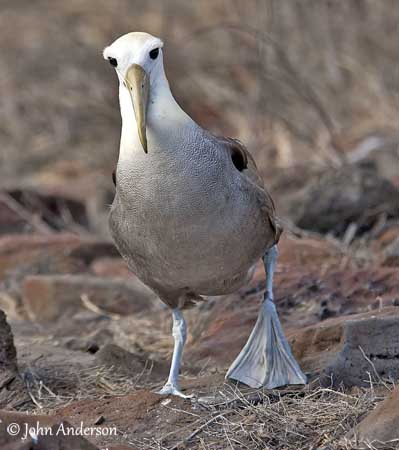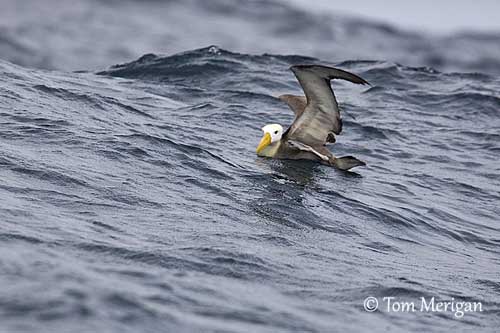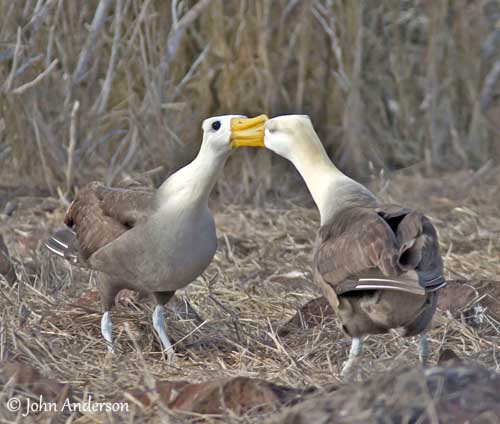
Fr: Albatros des Galápagos
All : Galapagosalbatros
Esp : Albatros de las Galápagos
Ital : Albatro marezzato
Nd: Galápagosalbatros
Sd: Galapagosalbatross
Photographers:
John Anderson
John Anderson Photo Galleries
Tom Merigan
Tom Merigan’s Photo Galleries
Text by Nicole Bouglouan
Sources:
HANDBOOK OF THE BIRDS OF THE WORLD vol 1 by Josep del Hoyo-Andrew Elliot-Jordi Sargatal - Lynx Edicions - ISBN: 8487334105
L’ENCYCLOPEDIE MONDIALE DES OISEAUX - Dr Christopher M. Perrins - BORDAS - ISBN: 2040185607
A GUIDE TO THE BIRDS OF COLOMBIA by Steven L. Hilty and William L. Brown - Princeton University Press – ISBN 069108372X
BirdLife International (BirdLife International)
Wikipedia, the free encyclopaedia
Waved Albatross
Phoebastria irrorata
Procellariiforme Order – Diomedeidae Family
BIOMETRICS:
Length: 85-93 cm
Wingspan: 230-240 cm
Weight: 3000-4900 g
DESCRIPTION:
The large size and the long wings make the Waved Albatross the largest breeding birds in Galapagos. It is unique with its pale head contrasting with dark body plumage.
Its name derives from the “wave-like” pattern of the adult plumage.
The adult has sooty-brown body, darker on the upperparts, but the rump is white, sparsely barred sooty-brown.
On the underparts, there are numerous narrow white vermiculations from upper breast to vent. Underwing is whitish, with mottled greyish-white coverts.
Head and neck are whitish, washed ochraceous-yellow, mainly on crown, nape, hindneck and neck base.
The long heavy bill is dull yellow. The eyes are dark brown. Legs and webbed feet are pale bluish.

Both sexes are similar. They can live up to 30-40 years.
The juvenile has whiter head and duller bill.
The immature has uniform dark brown plumage with greyish-white underwing-coverts.
VOICE :SOUNDS BY XENO-CANTO
The Waved Albatross is silent at sea, but during the displays, it becomes noisy and we can hear loud, drawling calls “ha-ha-ha” and “whoo-oo”. Both mates often engage in bill clattering and honking.

HABITAT:
The Waved Albatross is marine and mainly pelagic. It breeds among boulders, on bare lava in fairly open areas with bushes.
It needs a part of flat land for easier landing and take-off. It is usually found close to the ocean, near the feeding areas.
RANGE:
The Waved Albatross breeds on Española Island, Galapagos and La Plata Islands off Ecuador. It may approach the coast in areas of Humboldt Current.
This species is the only one exclusively tropical.

BEHAVIOUR:
The Waved Albatross feeds from the water surface. It takes large fish, squid and crustaceans. But the squid comes close to the surface at night, thus, this species feeds mostly by night. It also engages in piracy on boobies (Sula). It forages 10-100 km away from the nest-site to get food.


During the breeding season, the pair displays noisily. Ritual and complex courtship behaviour resembles a synchronized ballet with sounds and movements. The pair-bonds are long-lasting, usually for life.
They use series of stereotyped postures repeated over and over again, with the birds facing each other. Mutual preening is usually reported too.

They perform a highly spectacular dance, the “Ecstatic Ritual” including as exaggerated “Head-swaying Walk” and other movements. We can also see a beautiful sequence during which both mates perform bill circling, bowing, bill-clattering and honking.

The Waved Albatross leaves Galapagos Islands between January and March, and disperse eastwards to the waters of Humboldt Current, off Ecuador and Peru.
The immature birds may remain in these waters until they are ready to breed.

FLIGHT:
The Waved Albatross often glides on motionless extended wings and for long periods of time. It also follows the updrafts near the waves and troughs.
Its flight is very graceful but fast, making both landing and take-off sometimes difficult.
For this reason, they usually live on high cliffs, and need a flat area from where they can take-off and land more safely, avoiding sharp rocks and cacti.
They are able to fly long distances over the ocean.

REPRODUCTION:
The Waved Albatross is monogamous and pairs for life. The breeding period starts in April.
They can nest in large aggregations, but pairs are usually spread out in loose groups.
This species does not build any nest and is the only one of this family which lays the single egg in a natural depression and directly on the ground. Sometimes, the egg is moved by the adults during the long incubation, and can be lost by falling into crevices or hollows in rocks.

The female lays one whitish egg with rufous tinge on the larger side. Both parents incubate during two months, with stints of 5-22 days.
At hatching, the chick is covered in thick blackish-brown down. When it is two weeks old, it is left in crèche or nursery while parents go to sea for fishing. When they return, they feed the chick with pre-digested oily fish liquid. The young fledges about 165-167 days after hatching, and it is able to fly. It will be sexually mature between 3 and 6 years.
It leaves the colony in January and spends several years at sea, until it can breed.

DIET:
The Waved Albatross feeds on large fish, squid and crustaceans.
It catches its preys from the surface. It may steal food from boobies (Sula). It often feeds at night, when the squid reaches the surface.

PROTECTION / THREATS / STATUS:
The Waved Albatross is classified as Critically Endangered by BirdLife International.
This species has small breeding range on islands. It is threatened by harvesting for human consumption, by the fishing techniques using long lining, as well along the coasts as when it follows the fishing vessels.
Nest predation by introduced cats and rats on the Isla de la Plata threatens this small population. Eggs and young are still collected too.
Some conservation measures are in progress, in order to protect these very threatened beautiful seabirds.
